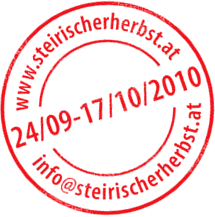 | Paulina Olowska (PL)
Natasza, Workers Canteen and Flowers
| |

Natasza, Workers Canteen and Flowers, 2010
Installation Three reconstructed neon signs from Warsaw
“Onethousandsixhundredseventeen Neons in Warsaw“, 2010
Performance, 24/09, 6 pm
Reading of the complete list of neon signs produced by the company “Reklama“ in the 1960s in Warsaw Public Recitation: Ryszard Kalowski
In collaboration with Polish Culture Institute, Wien
Andreas-Hofer-Platz, roof of the gas station/car park
What are three old neon signs from the 1950s and 1960s in Warsaw doing on the roof of the listed gas station building built over an underground car park in Graz?
Paulina Olowska lobbies for the restoration and reconstruction of old neons that once gave the city of Warsaw its unique “face” – an image that ran counter to the drab picture that the “West” likes to paint of Eastern Europe. Humorous and sprightly flickering advertising messages with their own symbolism that put a modern, cosmopolitan face on dreary Stalinist buildings in the Polish metropolis during Socialist times. Warsaw saw the birth of a veritable culture of neon advertisements installed for all to see on the high modern buildings of the city. Today these neons are silent witnesses of the symbolism and economy of Eastern European Socialism. Olowska discovered one such sign on an old postcard: a “Krowa” (cow) peeking with one eye from behind a milk bottle emblazoned above the entrance of a popular canteen and milkbar. A bouquet of flowers was presented for outstanding achievements in the heyday of Socialism. And the three Russian babushkas? – They were an advertisement for a Russian Eastern-bloc gift shop chain called “Natasza.”
The “Reklama” company is said to have built 1617 neon signs in Warsaw in the 1960s. As a performance conceived by Olowska, an employee of the Polish company that built the reconstructions for Graz according to original plans will read out all of the names of the neon signs from the roof of the gas station on the evening of the opening. A nostalgia of the erased poetry of the jargon of advertising in Socialist Eastern Europe? Now that the roofs of Warsaw have been taken over by the aggressive consumer world of the West? Perhaps Olowska’s intervention of bringing these three strange immigrants from Warsaw to Graz, where they can be made to light up once again, stands for a politics of poetics that reflects an Austrian experience of Socialist modernism – for a limited time, naturally.
Video

Commissioned by steirischer herbst
In co-operation with the Center for Social Research at the Karl-Franzens University Graz & Institute for Contemporary Art (IZK) of Graz University of Technology
With thanks to Hans Kupelwieser
Project supporter Land Steiermark
Project sponsor Think!, Gebrüder Weiss & Alpenländische Schilderfabrik
 |
 24/09 - 02/11
24/09 - 02/11
Utopia and Monument II
Fri 24/09, 5 pm
Vernissage at the exhibition pavilion, Tummelplatz
6 pm
Performance
Paulina Olowska
Onethousandsixhundredand-
seventeen Neons in Warszawa
Andreas-Hofer-Platz
(Roof of carpark)
Interventions of the Institute for Contemporary Art
at the exhibition pavilion
Thu 30/09, 4 - 7 pm
Performative Input
Thu 07/10, 4 - 7 pm
Installation
Thu 14/10, 4 - 7 pm
Sound & media installation
Admission free
Paulina Olowska
Born in Gdansk (PL) in 1976; lives in Raba Nizna (PL).
 24/09 - 02/11
24/09 - 02/11
Utopia and Monument II
Fri 24/09, 5 pm
Vernissage at the exhibition pavilion, Tummelplatz
6 pm
Performance
Paulina Olowska
Onethousandsixhundredand-
seventeen Neons in Warszawa
Andreas-Hofer-Platz
(Roof of carpark)
Interventions of the Institute for Contemporary Art
at the exhibition pavilion
Thu 30/09, 4 - 7 pm
Performative Input
Thu 07/10, 4 - 7 pm
Installation
Thu 14/10, 4 - 7 pm
Sound & media installation
Admission free
Paulina Olowska
Born in Gdansk (PL) in 1976; lives in Raba Nizna (PL).


